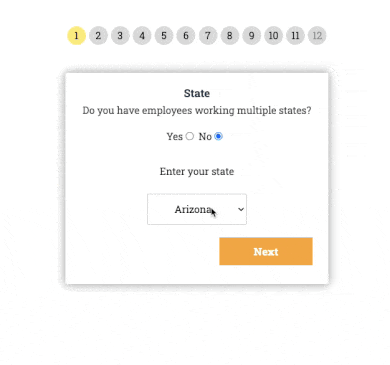

Washington employee handbook overview
When it comes to creating your Washington employee handbook, it is necessary to include both state-specific and federal policies. Whether all of your employees are in Washington or only a few, you will require a Washington-specific handbook to ensure that your workers understand the policies and privileges provided by their state.
The mandatory state policies for Washington, federally required policies, and other optional policies can be found below.
What should be included in a Washington employee handbook?
Every handbook should include Federal, State, and (if applicable) City-specific policies. Below are Washington-specific policies that should be included in your handbook.
Effective January 1, 2025, an expanded Washington Paid Sick Leave policy is required. New and existing customers will receive the updated policy.
- Washington State Paid Sick Leave: Employees earn at least one hour of paid sick leave for every 40 hours worked. Sick leave can be used for several reasons including illness, injury, and caring for family members.
- Washington State Paid Family and Medical Leave: Eligible employees may apply for benefits through the Washington Employment Security Department (ESD) for family leave and medical leave when they are facing serious illness or injury, a newborn baby or adoption, or certain military events.
- Washington Meal Breaks and Rest Periods Policy: Employers must provide a meal period for all shifts longer than 5 hours, and different break times depending on the length of the shift.
- Washington Lactation Accommodations Policy: Reasonable accommodations are required to be provided for nursing mothers for up to two years after childbirth.
- Washington Leave for Victims of Domestic Violence Policy:Employers are required to provide employees with leave for victims of domestic violence, sexual assault, or stalking.
- Washington State Jury Duty Policy: Employees will be allowed to take leave for time spent responding to a summons for jury duty, and will not be required to use annual, vacation, or sick leave for time spent responding to a summons for jury service.
- Washington State Final Paycheck Policy: When an employee is terminated, the company will pay the employee a final paycheck on the next regular payday.
- Washington Emergency Response Leave: Employees who work as volunteer emergency responders, including firefighters, reserve officers, and Washington Civil Air Patrol personnel are provided unpaid leave to respond to an emergency call. This applies to companies with 20 or more employees.
City-specific policies that should be included in your Washington Employee Handbook
Some states have cities or counties that require specific policies to be included for employees that are based there.
- Seattle, WA Specific Policies
- Seattle Sick and Safe Time Policy: Employers are required to provide employees based in the city of Seattle with paid sick and safe time off work to attend to various obligations.
- Tacoma, WA Specific Policies
- Tacoma Sick Leave Policy: Employers are required to provide employees who work in Tacoma with paid sick leave.
Create your Washington employee handbook now
Federal Policies
Don’t forget about federal policies
There are policies that should be included in every handbook to comply with US labor and employment law. Many states require additional provisions. However, this list includes core federal requirements and best practices applicable to most businesses.

Core federal policies
- Equal Employment Opportunity and Anti-Discrimination Policy Show me!
- Anti-Harassment and Complaint Procedure Show me!
- Family Medical Leave Act (FMLA) Policy Show me!
- Americans with Disabilities Act (ADA) & Reasonable Accommodation Policy
- Military Service Leave (USERRA)
- Wage and Hour Compliance Policy (FSLA)
- At-Will Employment Notice Show me!
- Polices if you employ federal contractors (Pay Transparency Policy, Whistleblower Protection, Drug-free Workplace Policy)
Highly recommended policies
- Workplace Violence Prevention Policy
- Code of Conduct Policy
- Nursing Parents Policy
- Conflict of Interest and Business Ethics
- Disciplinary Procedures
- Use of Company Property
- Employee Classification and Pay Practices
- Health and Safety Policy
- Confidential Company Information
- Open Door Policy
- Receipt of Non-Harassment Policy
- Use of Communication and Computer Systems
- Workplace Searches and Inspections
Additional policies to include
- Industry-specific policies
- Sick Leave, Vacation Leave, PTO policy
- Company Vehicles Policy
- Punctuality and Attendance
- Benefits
- Working Schedule
- Employment Records
- Smoking
- Overtime
- Performance Reviews
- Social Media Policy
- Remote Work Policy
- Introductory Period Policy
- References
- Hiring Relatives and Significant Others
- Business Expense Reimbursement
Get all recommended policies from the free handbook builder.
Washington labor law posters
Understanding labor law poster requirements can be a bit like trying to decode a complex puzzle. You need to comply with both state and federal requirements.
Why Should I Care About Displaying Posters?
You might be wondering why it's so important to display these posters in the first place. State and Federal laws mandate that employers must have up-to-date labor law posters conspicuously displayed for their employees. Failing to do so not only results in steep fines (up to $35,000 in federal fines and additional state fines) but also exposes you to real liability.
Consider this scenario: if an employee decides to bring a lawsuit against your company, and you don't have the required posters or they are outdated, you could face even more significant problems:
- Statute of Limitations: Normally, there's a limited window within which an employee can file a lawsuit against you. However, if you didn't inform your employees of their rights through proper poster display, a court might decide that the statute of limitations doesn't apply.
- Operating in Bad Faith: Courts may determine that you were intentionally withholding information from your employees, which could lead to a finding that you were operating in bad faith. This can substantially increase your liability.
What Are the Requirements for Displaying Labor Law Posters?
Labor law posters must be displayed at every physical location where you have employees, and they need to be conspicuously displayed for all to see.
- If you have a hybrid workplace with both in-person and remote employees, you'll need physical posters at your facilities and electronic distribution to your off-site workers.
- For fully remote companies, you can distribute posters electronically by sharing a permanent link to the appropriate posters.
- Some posters also need to be visible to job applicants, such as FMLA, Equal Employment Opportunity, and Employee Polygraph Protection posters, as per the guidance provided by the Department of Labor.
What Labor Law Posters Do I Need to Display?
You'll need both Federal and State labor law posters for each state where you have employees. The good news is that all the posters you need are provided for free by the federal government and state departments of labor. You've probably seen those convenient "all-in-one" laminated posters, but if you prefer, everything you need is also available as a free, printable document from the Washington Department of Labor.
Federal Poster Requirements
Determining which federal posters you're required to display can be influenced by various factors, including your industry, the size of your company, benefits you provide and union affiliation.
The good news is that there's a handy tool to help you understand precisely which federal posters your company needs. You can use the Federal Poster Advisor tool to determine your specific federal poster requirements.
Washington Labor Law Poster Requirements
You can refer to the Washington Department of Labor for free, printable posters.
Download Washington labor law posters hereWashington pay transparency law
Pay transparency laws mandate that employers disclose salary ranges for positions to job applicants, and sometimes even to existing employees. The primary objectives of these laws are to reduce gender and racial wage gaps and to foster a more equitable and competitive job market. These laws vary in terms of scope, with some applying to all employers and others targeting businesses of a certain size or type.
- Washington’s pay disclosure law applies to employers with 15 or more employees. It requires them to disclose the minimum and maximum salary for a position when it is offered and upon request after an initial job offer.
- It applies to employers with 15 or more employees if they have at least one Washington employee or recruit in Washington.
- Penalties for non-compliance include a fine of $500-$1,000 or a percentage of damages.
Learn more about pay transparency laws by state
What’s included with the handbook builder
Creating a new handbook only takes a few minutes. And it’s easy. You can get started by answering a few interactive questions about your company. A few examples:
- How many employees do you have?
- Do you have employees in multiple states?
- Do you have an introductory period for new employees?
- Do you offer paid holidays?
- What is your payroll schedule?

Communicating your company culture
In all businesses, building a strong company culture can be essential to boosting morale and aligning employees. Arguably, it is even more key for small businesses. With a small team, the impact of a strong culture is made more apparent. Here are some important things to remember when building a strong company culture.
Evaluate Your Current Culture
Since company culture is primarily determined at the top, here are some key questions to ask your leadership team to evaluate where your culture currently stands:
- Are we open about how things work at our company?
- Do our employees know what is expected of them?
- Do we value our employee’s feedback?
- How do we demonstrate that our employees are valued?
- What are our company values?
- Do we clearly express these values?
Set Your Goals
From your answers to the previous questions, pinpoint what is lacking and make goals to improve on those areas. This could mean having clearer communication for employee expectations, defining company values, or creating monthly team-building activities to build morale.
Respecting Employee’s Work-Life Balance
A large part of communicating that your company values its employees is demonstrating respect for their lives outside of work. A strong employee handbook can allow this to be done in a clear, effective way. Company leaders should detail expectations, but also be open about their own work-life balance to build transparency. Trust is key in a great company, and when leaders show genuine empathy for employee responsibilities at home, a foundation for transparency and cooperation is built.
The Link Between Culture and Happiness
Many surveys and analyses of employee feedback indicate that the majority of employees care as much about the culture of the company they work for as their salary. In small companies, culture is frequently undervalued. In order to reduce turnovers and increase recruitment, companies need to understand that there is a link between strong culture and the one important question employees think about regularly: “Am I happy working here?”.
Understanding and Communicating Your Company’s Culture
In order to effectively communicate your company’s culture, you need to understand it. By asking your team the right questions, setting goals, and valuing employees, you can be sure to be on the right track.
Communicating this culture is an essential next step toward aligning with your employees. Not every culture is a good fit for every employee, and being honest upfront is important for making sure you are hiring employees best aligned not only with the skills a company requires, but the culture of the workplace. Research shows that when looking for a job, 77% of people polled would consider a company’s culture and work atmosphere before applying. By clearly communicating your company culture up front, you can ensure that more candidates who align with your team values will apply for a position.

Still have questions?
Can’t find the answer you’re looking for? Please chat with our friendly team.
Contact UsEmployee Handbook Resources
Best practices, guidance and information for companies





